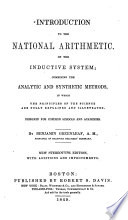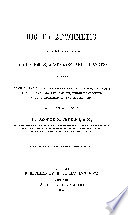 | George Roberts Perkins - 1846 - 266 páginas
...first term, the last term, and the number of terms, to find the common difference, we have this • RULE. Divide the difference of the extremes by the number of terms, less one,. EXAMPLES. 1. The first term of an arithmetical progression's 5, the last term is 176, and the number... | |
 | Almon Ticknor - 1846 - 274 páginas
...first term, the last term, and the number of terms being given, to find the common difference. RULE I. Divide the difference of the extremes by the number of terms, less 1, and the quotient will be the common difference sought. 1. The extremes are 3 and 39, and the number... | |
 | Pliny Earle Chase - 1848 - 244 páginas
...Then the difference of the extremes 24, must be 8 times the common difference, which is therefore 3. RULE. \ Divide the difference of the extremes by the number of terms less one, and the quotient will be the common difference. This difference repeatedly added to the less, or subtracted from the... | |
 | Zadock Thompson - 1848 - 184 páginas
...first term, the last term, and the number of terms given to find the common difference. RDI.E. — Divide the difference of the extremes by the number of terms, less 1, and the quotient will be the common difference. 2. If the first term of a series be 8, the last... | |
 | Benjamin Greenleaf - 1849 - 336 páginas
...quotient will be the common difference. Thus, 27-:-9 = 3, the common difference. Hence the following RULE. — Divide the difference of the extremes by...less one, and the quotient is the common difference. EXAMPLES FOR PRACTICE. 1. The extremes of a series are 3 and 35, and the number of terms is 9 ; what... | |
 | Nathan Daboll, David Austin Daboll - 1849 - 260 páginas
...last day ? Ans. 33 miles. CASE n. • ' The first term, last term, and number of terms given, to f,nd the common difference. RULE. Divide the difference of the extremes by the number of terms less 1, and the quotient will be the common difference. EXAMPLES. 1. A man bought 17 yards of cloth in arithmetical... | |
 | George Roberts Perkins - 1849 - 344 páginas
...the first term, the last term, and the number of terms, to find the common difference, we have this RULE, Divide the difference of the extremes by the number of terms, less one. EXAMPLES. 1. The first term of an arithmetical progression is 5, the last term is 176, and the number... | |
 | James Bates Thomson - 1849 - 438 páginas
...12 hours? 604. To find the common difference, when the extremes and the number of terms are given. Divide the difference of the extremes by the number of terms less 1, and the quotient will be the common difference required. OBS. The truth of this rule is manifest... | |
 | Benjamin Greenleaf - 1850 - 368 páginas
...divided by the number of common differences, the quotient will be the common difference. Thus 16 -5- 8 = 2 is the common difference. RULE. — Divide the...What is the common difference ? OPERATION. 45 — 3 22—1 = 2 Answer. 2. A man is to travel from Albany to a certain place in 11 days, and to go but 5... | |
 | George Roberts Perkins - 1850 - 356 páginas
...the first term, the last term, and the number of terms, to find the common difference, we have this RULE. Divide the difference of the extremes by the number of terms, less one. EXAMPLES. 1 . The first term of an arithmetical progression is 5, the last term is 176, and the number... | |
| |